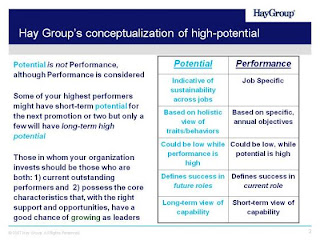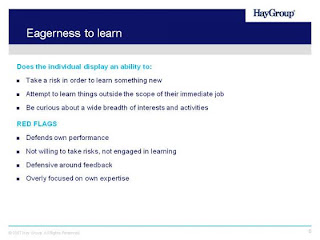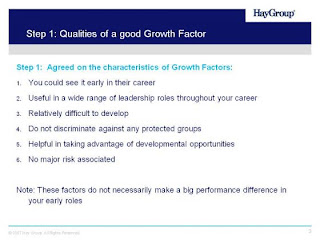Identifying High Potentials
Identifying High Potentials
Community: Talent Development Track: The High Performance Organization
Webcast: Webcast Aired: July 28, 2011
Every high potential in your organization likely began their career like any other entry level employee. So, what turned them down the leadership path? Who saw their potential and acted? Organizations spend thousands, even millions, annually to make sure the best and brightest are benefiting from learning, assessments, and robust development programs. Learn what strategies can be used to accommodate organizations as they identify high potential prospects from their first day on the job to their official initiation as a future leader.
Some key questions:
What behaviors set high potentials apart from other workforce segments?
What methods can managers use to help high potential prospects “test the waters” of leadership?
-------------------------------------------------------------------------------
1)

What is potential? What are the growth factors that identify potential, and specifically, “potential for what?”
Answering these questions is important to determine if organizations have the talent and capability to develop and implement the strategies that will enable success in today’s highly competitive and changing business world. It’s worth noting that:
The ability of leaders to implement one type of strategy may not be the type needed to implement another
Ensuring the right people are in the right roles at the right time to deliver on strategy now and in the future (the essence of Talent Management)
Predicting potential is a high-stakes game. You are not just dealing in specifics such as previous performance record, you are deciding where to place the organization’s bets in investing time and resources to develop future leaders.
2)

Every high potential in your organization likely began their career like any other entry level employee. So, what turned them down the leadership path? Who saw their potential and acted? Organizations spend thousands, even millions, annually to make sure the best and brightest are benefiting from learning, assessments, and robust development programs. Learn what strategies can be used to accommodate organizations as they identify high potential prospects from their first day on the job to their official initiation as a future leader.
Some key questions to answer are:
What behaviors set high potentials apart from other workforce segments?
What methods can managers use to help high potential prospects “test the waters” of leadership?
3)

Growth Factor is defined as: a characteristic of a person that is related to responsiveness to opportunities for leadership development or commitment to seeking professional development. Growth Factors are signs of readiness to take advantage of development opportunities and to stretch one’s capabilities beyond the current set. These factors are more focused on the long-term development of potential rather than immediate results –in fact, depending on the job accountability, the factors may or may not help the person achieve excellent results right now. At entry levels, achievement, analytical thinking, and taking initiative predict performance success better than the Growth Factors.
4)

The final growth factors from Hay Group’s research were:
Supported by observations in coaching and following the careers of many leaders
Agreed on as making sense by the experienced coaches and consultants
Met the original criteria for what makes a good characteristic of potential
Consistent with external academic research*
* Ruth Malloy from Hay Group shared mainstreams of published research underlying work in this topic:
Work by Eliot Jaques and Gillian Stamps on the timespan of discretion
Work by Kurt Fischer’s on measuring cognitive abilities
Emotional Intelligence research summarized by Dan Goleman
Many measures of cognitive abilities (i.e., Watson Glaser, Raven’s Progressive Matrices, etc.)
Competency measurement and the development scalings of those measurements (McClelland, Boyatzis and Spencer & Spencer)
Work by Carol Dweck on growth mindset and fixed mindset; attitudes towards growth and intelligence and their affect on people’s abilities to learn
5)

Outstanding employees score higher than typical employees on the growth factors.
For senior employees the difference is even greater.
6)

A general interest in learning strongly underpins any personal development. It reflects an underlying belief that one’s talents are fundamentally develop-able (as opposed to fixed) and are worth developing for their own sake. An active pleasure in learning and growing greatly enhances the likelihood that the person will make the efforts necessary to develop new competencies as or before they are needed.
7)

Being able to see issues or concerns from diverse viewpoints, thinking them through deeply and seeing less obvious connections to other issues or to other parts of the organization enables people both to understand and to exploit the value of growth experiences. Breadth of perspective becomes increasingly important as future leaders take on larger roles within the organization, and within those roles must invent and execute ways to coordinate with other parts of the organization (and at high levels, with other organizations).
8)

Recognizing and rewarding this ability early on is crucial as our research shows that senior executives are typically less self aware than lower level managers. The ability to listen and accurately understand other people, especially when their perspectives are different from one’s own, helps individuals to learn from others and to do so rapidly, and supports their ability to take feedback from others constructively. In addition, lack of this characteristic is one of the most common “de-railers” for senior leaders.
9)

Personal growth, including the development of leadership skills, is often painful and it is characterized by setbacks or criticism in the process. Individuals who can maintain an even temper, emotional objectivity, and who have effective coping strategies for emotional strain are better able to learn from (rather than defend against) pain. The ability to maintain emotional balance and to be resilient is a prerequisite for learning from feedback. It also supports persistence when in larger roles which are typically more challenging and emotionally difficult.
10)

A variety of factors can throw a development plan off-track. These “derailers” are often unintentional and their source can be the organization, as well as what the individual brings.
11)

Know what you need from people
Start with strategy to define the behaviors needed from key roles
Identify long-term potential through the growth factors
Not just job-specific abilities or current performance
Potential for what?
Distinguish between long term leadership potential and short term job-specific potential.
Fulfillment of potential
Organizations need to take risks to help people grow, promoting development through stretching career moves, coaching and training. This implies minimizing the organization’s complicity in career derailment.
Create enabling systems to effective talent management
rocesses need to help find and promote hidden diamonds and there needs to be mechanisms that inject objective data into the decision making processes around best deployment of talent. Through good talent systems organizations can ensure their people fulfil their potential and thus contribute to the future success of the organization. These systems also need aligning with other levers such as reward.
============================================================================
Ruth Malloy
Managing Director of Transforming Learning
Hay Group, Inc.
Ruth Malloy is Managing Director of Transforming Learning. Transforming Learning provides organizations with research-proven diagnostics, e-learning tools and on-line solutions to develop leaders throughout the whole organization.Ruth joined the Hay Group in 1991, and specializes in the areas of Leadership Transformation, Talent Management and Capability Assessment. She has worked with Fortune 500 companies in various industries including Technology, Financial Services, Food and Beverage and Consumer Goods.
http://www.hci.org/lib/identifying-high-potentials

1 Comments:
A high potential has, besides good results, also these three distinctive qualities: ambition, power and commitment.
Post a Comment
<< Home